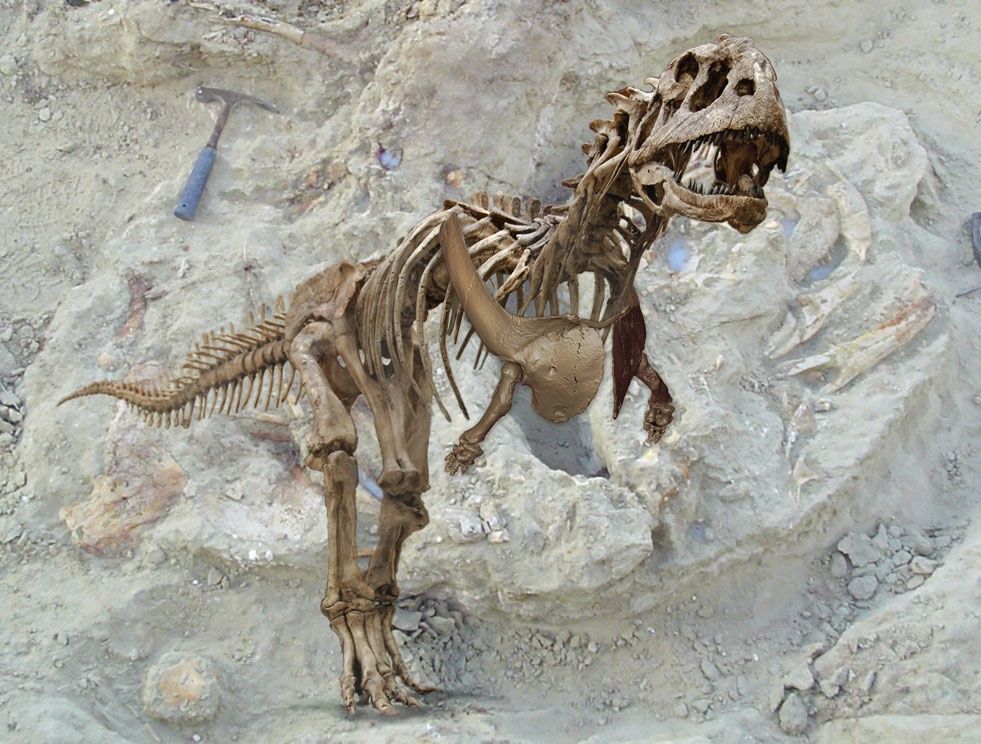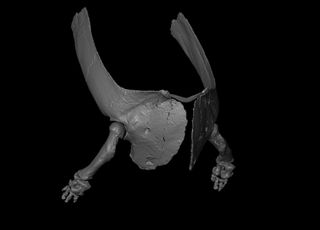Big Mean Dinosaur Had Stubby Little Arms and Fat Fingers

Updated at 7:45 p.m. ET
A fearsome carnivorous dinosaur known for eating its own kind probably wasn't holding onto its meal as it ate: Its arms were far too short and stubby, a new fossil find suggests.
Majungasaurus crenatissimus was a 21-foot-long (6.4 meters) predator that was "pretty much the top dog" in what is now Madagascar 66 million years ago, at the end of the Cretaceous Period, said Stony Brook University graduate student Sara Burch. Burch analyzed a recently discovered, nearly complete forelimb of this ancient animal, the first ever found preserved. In contrast to the dinosaur's bulky body, Burch found that its arms weren't even a foot (0.3 meters) long.
"When you get to the lower arm and the hand, it's really weird," Burch told LiveScience. "The lower arm is very short but thick, and the bones are pretty robust. So it's not necessarily a thin, wimpy arm, it's just very, very short."
The fingers of Majungasaurus were so stumpy, in fact, that the researchers aren't sure they were separated; the hands may have been more like paddles than like human hands.
"Even if they were separate, they'd be very short," Burch said. "Imagine if your hand just had the first knuckles sticking out."

Though many Majungasaurus fossils have been found, the dinosaur's forelimb is rarely preserved in the fossil record. Burch was able to unravel the mysteries of this body part thanks to a nearly complete Majungasaurus skeleton unearthed in Madagascar in 2005. She also cataloged other partial Majungasaurus arm bones from Madagascar.
Sign up for the Live Science daily newsletter now
Get the world’s most fascinating discoveries delivered straight to your inbox.
The researchers don't know what Majungasaurus used its stubby arms for, though the unusual shape suggests they did have a specific purpose, Burch said. Whatever it was, it certainly wasn't for grasping prey, she said.
The forelimb find helps researchers understand the huge diversity of limbs of theropod dinosaurs like Majungasaurus, Burch said. Because the dinosaurs walked on their back two legs, their front limbs were free to evolve for a multitude of tasks. Last year, researchers even found a one-fingered dinosaur in Mongolia.
"Majungasaurus really typifies how bizarre, how crazy they can really go and still have a forelimb," Burch said.
You can follow LiveScience senior writer Stephanie Pappas on Twitter @sipappas.Follow LiveScience for the latest in science news and discoveries on Twitter @livescience and on Facebook.
Editor's Note: We have updated the article to correct the spelling of the researcher's first name and the genus name of the dinosaur.

Stephanie Pappas is a contributing writer for Live Science, covering topics ranging from geoscience to archaeology to the human brain and behavior. She was previously a senior writer for Live Science but is now a freelancer based in Denver, Colorado, and regularly contributes to Scientific American and The Monitor, the monthly magazine of the American Psychological Association. Stephanie received a bachelor's degree in psychology from the University of South Carolina and a graduate certificate in science communication from the University of California, Santa Cruz.
Most Popular


